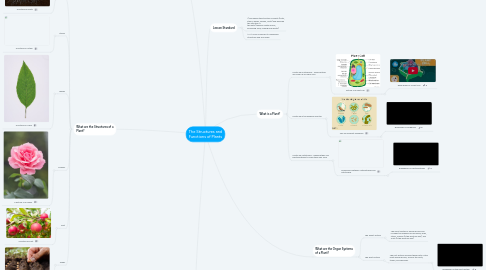The Structures and Functions of Plants
by Olivia Lowry


1. Lesson Breakdown
2. What are the Functions of a Plant?
2.1. Take in water
2.2. Take in air
2.3. Produce food
2.3.1. Why do we need plants?
2.4. Make new plants
3. What are the Structures of a Plant?
3.1. Roots
3.1.1. A picture of Roots
3.2. Stems
3.2.1. A picture of a Stem
3.3. Leaves
3.3.1. A picture of a Leaf
3.4. Flowers
3.4.1. A picture of a Flower
3.5. Fruit
3.5.1. A picture of Fruit
3.6. Seeds
3.6.1. A picture of Seeds
4. Lesson Standard
4.1. 1) Recognize the structure of plants (roots, stems, leaves, flowers, fruits) and describe the function of the parts (taking in water and air, producing food, making new plants).
4.2. 1.LS1: From Molecules to Organisms: Structures and Processes
5. What is a Plant?
5.1. Plants are multicellular - meaning they are made up of many cells.
5.1.1. Picture of a Plant Cell
5.1.1.1. Break down of a Plant Cell
5.2. Plants are in the kingdom Plantae.
5.2.1. The Six Different Kingdoms
5.2.1.1. Breakdown of Kingdoms
5.3. Plants are Autotrophs - meaning they use photosynthesis to make their own food.
5.3.1. Differences between Heterotrophs and Autotrophs
5.3.1.1. Breakdown of Photosynthesis
6. What are the Organ Systems of a Plant?
6.1. The Shoot System
6.1.1. The shoot system is above ground and includes the organs such as leaves, buds, stems, flowers (if the plant has any), and fruits (if the plant has any).
6.2. The Root System
6.2.1. The root system includes those parts of the plant below ground, such as the roots, tubers, and rhizomes.
6.2.1.1. Breakdown of the Root System

